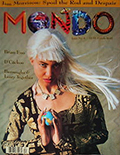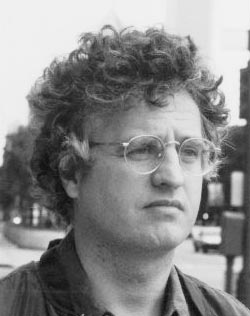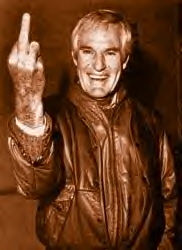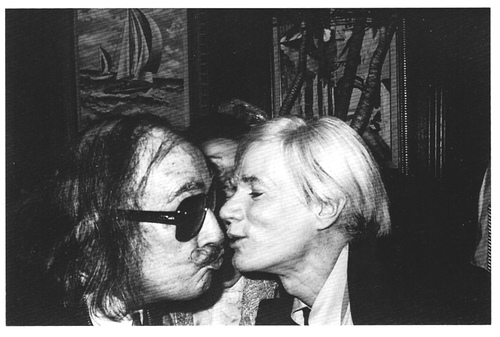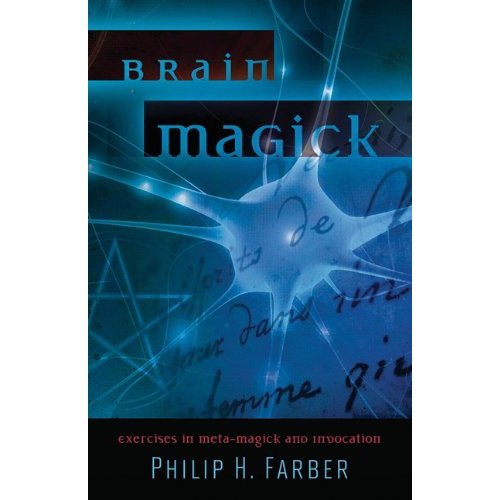
“Am I processing  my sensory  information  via Circuit Four: • Am I concerned or motivated by my family or sexual relationships? • Am I horny? • Am I motivated by the way I appear to others, in regard to my masculinity, femininity, or androgyny?”
The following excerpt is from BRAIN MAGICK: EXERCISES IN META-MAGICK AND INVOCATION by Philip Farber .  Check out the entire book!
The Nature of a State
Consciousness flows, ever-changing, from one moment to the next. However minutely or broadly, each nanosecond of experience differs from the preceding one. When we talk about a “state of consciousness,†we make a generalization about a collection of such moments, that some aspects of consciousness remain constant, or at least similar, for a period of time. Even so, sensory experience continues its kaleidoscopic change. When we meditate, we ease into a session, first getting comfortable in our posture, then getting into the flow of meditation, then easing back out, aware of comfort or discomfort in our bodies, and turning our attention back outward. Rather than a singular state called “meditation,†we may find a continually shifting experience—a process rather than a thing. A hypnotic trance induction has a beginning, middle, and end. A psychedelic experience rises and falls as chemical levels in the blood- stream peak and diminish. Sleep is characterized by several stages through the night.
Knowledge of how we get into and out of different states of consciousness can be incredibly useful in the practice of magick. Some rituals require that the magician be in a particular state prior to beginning. Some rituals — particularly rituals of invocation — are all about inducing powerful altered states. It can be very important for a magician to be able to know when he or she is in a state, when the state is reaching its peak, and when it might be fading. In general, we usually are not aware of the process by which we change and enter states. Think about the last time you were happy — you may remember the content of the experience, the stimuli that pushed you in that direction, but, unless you’ve played with these kinds of calibration techniques before, the actual feeling of the state coming on and building likely occurred on an unconscious level. That is, you might remember the wonderful present that someone gave you and how happy that made you, but perhaps not the actual process of exactly how it changed you. Similarly, in magical practices we may work hard to remember the words and symbols of a ritual while the process of the experience slips past our awareness. It’s okay. It’s a normal experience. Now, let’s find out how we can bring state changes into conscious awareness.
The nature of a state may best be understood by paying attention to the differences between one state and the next, and the differences from one moment to the next.
To notice a difference, we first have to calibrate, to notice where and what we are now. The simplest method is to ask, “What am I experiencing now?â€
Exercise 1.1 Physiological Calibration
To begin, find out how your body is functioning right now. Run through each of the physiology questions and answer them to the best of your ability.
Physiology
• What is the position of my body?
• Am I moving or still? How so?
• What are the positions of my arms, legs, hands, and feet?
• Is my heartbeat in my conscious awareness? If so, is it fast or slow, strong or weak?
• Is my breathing rapid, slow, even, uneven, shallow, or deep?
• Am I breathing from the upper part, middle, or bottom of my lungs?
• Which of my muscles are in use? Which are relaxed? How in use or relaxed are they?
Once you have determined the answers to these questions, you can change your state using Expansion and Contraction Breathing and run through the physiology modeling questions again, noting any changes that have occurred.
• Expansion and Contraction Breathing — at least five minutes: Imagine a circle around yourself, at about the diameter of your out-spread arms. Sit or stand in the center of that circle. Fill your lungs completely, with a slow, even inhalation. As you inhale, allow your attention to expand to fill the circle. As you exhale, slowly, evenly, and completely, allow your attention to contract to a single point in the center of your chest. Repeat.
How have the physical parameters of your state changed? Has your position changed? Or your heartbeat, breathing, and musculature?
Modeling Resources
We can be more precise in modeling states by identifying and measuring a variety of perceptions, behaviors, and beliefs that can help us to define the processes we refer to as states. Here are some more Modeling Resources that can be applied to states of every kind.
Sensory-Based Model
In the model of perception and behavior used in the field of Neuro-Linguistic Programming (NLP), thought and experience are sorted and represented through  “sensory representational systems,†visual, auditory, kinesthetic, olfactory, and gustatory—seeing, hearing, feeling, smelling, and tasting. These are not only the senses that we use to experience in the present; they are also the ways that we sort our thoughts and memories internally. A sensory-based model can give us some idea of what and, even better, how we are using our senses while in a particular state of consciousness. Reflect on the following questions.
• Am I aware more externally or internally?
• How much am I consciously aware in visual mode?
• Do the things I see (with eyes open or closed)
seem bright, dim, colorful, distant, close, large, small, shiny, dull, etc.?
• How much am I consciously aware in auditory mode?
• Do the things I hear sound loud, quiet, tonal, rhythmic, vocal, deep, high, distant, close, distinct, fuzzy, etc.?
• How much am I consciously aware in kinesthetic mode?
• Do the things I feel seem tactile, visceral, emotional, proprioceptive, mild, intense, large, small, tingly, pressing, moving, still, warm, cold, etc.?
• How much am I consciously aware in olfactory and gustatory modes?
• Do the things I taste and smell seem intense, mild, pungent, sweet, smoky, musky, fruity, sour, bitter, spicy, etc.?
• Is it easy or difficult to separate one sense from another?
• Are senses represented to consciousness as other senses, that is, sound experienced as color, color experienced as feeling, and so on?
• Am I experiencing from my own point of view, or seeing/hearing/feeling myself as if from someone else’s point of view?
• How much am I concerned with how I feel about my sensory experiences?
After calibrating and testing an altered state, what differences did you find? Which senses characterized your baseline state and which were you using during your altered state?
Eight Circuit Brain Model
The model of an Eight Circuit Brain was originally proposed by Timothy Leary as a way of sorting behavioral tendencies, imprints, “life scripts,†and “reality tunnels,†among other uses. The model was further expanded on by other writers and thinkers, including Robert Anton Wilson and Antero Alli. The following modeling questions are based on Wilson’s explanations of the model.
Am I processing my sensory information via
Circuit One:
• Am I motivated to move toward comfort and/or away from discomfort?
• Am I motivated toward food and drink?
Am I processing my sensory information via Circuit Two:
• Am I concerned about my importance relative to other people?
• Do I want to fight or run away?
• Is my behavior expressed as dominance or submission?
Am I processing my sensory information via Circuit Three:
• Am I thinking about things more than doing them?
• Am I motivated by logic, intellectual curiosity, or scientific interest?
• Am I talking a lot? Or talking to myself in my head?
Am I processing my sensory information via
Circuit Four:
• Am I concerned or motivated by my family or sexual relationships?
• Am I horny?
• Am I motivated by the way I appear to others, in regard to my masculinity, femininity, or androgyny?
Am I processing my sensory information via
Circuit Five:
• Do I experience movement of “energy,†“light,†“vibration,†or temperature in or near my body?
• Am I easily able to control my rate of breathing, heart rate, and comfort level?
• Do I feel “high,†“stoned,†“trippy,†“floating,†or otherwise positively experiencing a body/mind-based, sensory experience?
Am I processing my sensory information via Circuit Six:
• Do I recognize the experience I’m having as “magick†or “brain-change?â€
• Am I acutely aware of the social/cultural programming of myself or of others around me?
• Does human behavior seem like an abstract concept based on arbitrary, random, and easily altered rules?
• Am I aware of choices to alter, abolish, or create forms of my own inner programming?
Am I processing my sensory information via Circuit Seven:
• Am I conscious of experiences in terms of “past lives,†“future memories,†or “magical currents?â€
• Am I aware of the interconnectedness of things?
• Do ordinary things seemed imbued with symbolic meaning?
• Am I aware of or motivated by an evolutionary concern?
Am I processing my sensory information via Circuit Eight:
• Can my experience be described as “out of body,†“lucid dreaming,†“bilocation,†or “astral projection?â€
• Does reality itself seem like an abstract concept based on arbitrary, random, and easily altered presuppositions? (“There is no spoon.â€)
• Do concepts such as location, size, direction, time, and so forth seem meaningless, arbitrary, or laughable?
• Do I experience my universe as a singularity?1
What was the difference in experience between your calibrated baseline state and your altered state? Which circuits were characteristic of each state?
NLP Meta-Programs Model
Richard Bandler, one of the cofounders of NLP, originally suggested the idea of meta-programs as patterns of behavior that help us to organize other behaviors. Meta-programs help describe our general approach in a situation rather than the specifics of our perception and action. It is possible for us to organize our behavior using different, over- arching patterns in different states. Meta-programs have been further explored and developed by other NLP practitioners, including Leslie Cameron- Bandler and Robert Dilts. The following questions represent a very simplified version of the model, sufficient for basic state-modeling purposes.
• Are my behaviors motivated away from discomfort or toward pleasure?
• Are my behaviors motivated from my own internal decisions or based on the decisions of others?
• Is my attention more on myself or on others?
• Am I more concerned with generalities or de- tails? The big picture or the individual brushstroke?
• Is my attention directed toward past, present, or future?
• Am I thinking in a long time frame or a short one?
• Am I thinking about how things are alike? Or how things are different?
How did your general tendencies change from your baseline state to your altered state? What meta-programs were characteristic of each state?
Meta-Magick Energy Flow Model
The Energy Flow Model found its original inspiration in NLP techniques to access kinesthetic states, described by Richard Bandler, and Steve and Connierae Andreas. This is a very streamlined version, again sufficient for our present purpose. We will explore this technique quite a bit more, later in the book.
Track the kinesthetics of the experience as follows:
• Notice where in your body the feeling of the state begins.
• Notice where it moves to as the experience develops toward its peak.
• Pay attention to whether the feeling is moving or static, cycling or pulsing.
• Give the feeling a color. “If this feeling had a color, what would it be?â€
• Experiment by making the colored shape brighter, darker, richer, faded, larger, or smaller to determine which of these increases the feeling associated with the state.
• Notice any other changes in feeling as well as in what you might see, hear, taste, or smell.
What were the differences between your baseline energy flow and your altered state energy flow? What changes in colors, shapes and sizes could you perceive??â€
Exercise 1.2 Calibrate, State, Model, RepeatÂ
The techniques for altering consciousness listed below range from simple to moderately complex. Play with as many of these techniques as you comfortably can and attempt to quantify them according to the modeling resources.
Remember that the point of the exercises is not necessarily to learn as many altered states techniques as possible, but to learn how to model and understand what our minds and bodies do as we explore different states.
Here’s how it goes:
Calibrate, State, Model, Repeat
1. Calibrate your present state. Run through the modeling resource categories and questions and mark down the answers, simply and briefly. Use as many of these resources as you think appropriate for each task. It’s like filling out a questionnaire — make a list of your responses to each question that seems to apply. Skip any that do not apply to your particular experience. For now, forget about what any of it means. In fact, at this point it is just raw data, until we have something different to compare it to.
2. Enter into an altered state via one of the methods listed below. Enjoy it for as long as you’d like.
3. Then, immediately upon returning (or while remaining as much as possible in the state), use the modeling resources to build a model of the state. Use as many of these resources as you think appropriate for each task. Skip any that do not apply to your particular experience.
4. Repeat using a different technique to alter your consciousness. It’s not necessary to explore all of the methods given, just the few that might draw your interest. You can also use the modeling process with other techniques that you might be familiar with, along with those included here.
Database of Techniques
• Simple Zen—at least ten minutes: Sit in a position with your spine vertical and straight (a chair will do nicely). Allow your breathing to become relaxed and natural. Let it set its own rhythm and depth, however it is comfortable. Focus your attention on your breathing, on the movements of your chest and abdomen rather than on your nose and mouth. Keep your attention focused on your breathing. For some people an additional level of concentration may be helpful. You might add a simple counting rhythm, spoken in your head as you breathe: “One†on the inhale, “Two†on the ex- hale, and repeat. Or you might visualize your breath as a swinging door, swinging in on the inhale and out on the exhale.
• Ajna Monkey—at least one hour, days if you can manage it: The following method was suggested by Aleister Crowley in Magick in Theory and Practice. One imagines that all your perceptions and thoughts go to or arise from the Ajna chakra, the “third eye†located above the bridge of the nose, between the eyes. Begin by breathing deeply and fully, imagining that you send the breath to the Ajna, not to the lungs. Walk slowly and observe the movements of your legs. Reflect that the legs work because they are guided by nerve impulses from the brain, controlled by the Ajna. “The legs are automatic, like those of a wooden monkey: the power in Ajna is that which does the work, is that which walks. This is not hard to realize, and should be grasped firmly, ignoring all other walking sensations. Apply this method to every other muscular movement … Transfer all bodily sensations to the Ajna, e.g., ‘I am cold’ should mean ‘I feel cold,’ or better still, ‘I am aware of a sensation of cold’—transfer this to the Ajna, ‘the Ajna is aware,’ etc. … Finally, strive hard to drive anger and other obsessing thoughts into the Ajna. Develop a tendency to think hard of Ajna when these thoughts attack the mind, and let Ajna conquer them. Beware of think- ing of ‘My Ajna.’ In these meditations and practices, Ajna does not belong to you; Ajna is the master and worker, you are the wooden monkey.â€â€”Aleister Crowley2
• Chasing the Tail—at least ten minutes: Chasing the Tail is a simple meditation of self- observation. Sit quietly and pay attention to where your thoughts arise. When you think something—anything—the thoughts appear to come from a particular location in space, usually somewhere in your head or somewhere in your body, although occasionally a thought may seem to arise outside the physical body. Just note where the thought arises and let all other thoughts fall from your mind. As each new thought arises, just note where it comes from. If you have thoughts about the practice itself, note where they come from. If you have thoughts about noting where a thought came from, note where that thought came from.
Got it? Like a cat chasing its own tail, you turn your consciousness back on itself.
• The Betty Erickson Self-Hypnosis Method— at least five minutes: Sitting comfortably, with eyes open or closed, list (to yourself) three things that you can see, then three things you can hear, then three things you can feel. (For example, “I see the color of the wall, I see the person opposite me, I see the color of her hair, I hear the sounds outside the room, I hear people moving about, I hear my own breathing, I feel the cushion underneath me, I feel the air on my skin, I feel my hands on my lap … â€). Then narrow it down to a list of two things in each sensory mode, then one thing in each mode. Tell yourself, “As I count from ten down to one, I can go into a deep, comfortable trance.†Then count breaths backwards from ten to one and enjoy the trance that you are drifting into. This works most powerfully when the verbal listing within your head is timed in a rhythm with your breathing.
• Lucid Dreaming: Lucid dreaming begins when you become aware, while dreaming, that you are, in fact, asleep and dreaming.
Once you are aware that it is a dream, you can consciously take the experience in any direction. As an example of how we can work with dream states, consider this basic and effective method for lucid dreaming. Throughout the day, at least a dozen times during the day, test to find out whether or not you are dreaming. For instance, try to fly—if you are in a lucid dream, flying is easy—or read something, look away, then look back and read it again (in dreams, things rarely read the same way twice). There are many other such tests. If you get in the habit of doing this frequently, it carries over into your dream states and then, suddenly, the tests are positive and you are lucid dreaming. This is a popular and effective method used by dreamers all over the world. Along with other “pleasant dreaming†practices (for example, sleep late and when you wake in the morning, stay in exactly the same position and drift off again, wake under your own power, with no alarms, etc.), this will eventually induce lucid dreaming in most people, usually within a week or so.3
• Yogic Breath—at least ten minutes: Your lungs have three main areas: the bottom, which is controlled by movements of the diaphragm and is visible as a rising and falling of the abdomen (“abdominal breathingâ€); the middle, controlled by expansion and contraction of the rib cage; and the top, controlled by rising and falling of the shoulder blades. Each of these different kinds of breathing are associated with different states of consciousness. For purposes of the Yogic Breath, however, the key is simply to fill and empty all three of the areas of the lungs. Fill and empty your lungs completely but smoothly, without halting or straining. This is not hyperventilation—it is proper and full breathing, at a relaxed pace.
• Pranayama — Square Breathing — at least ten minutes: Once you are comfortable with the Yogic Breath, you can begin to slow it down a bit. Figure out your usual time for an exhalation or inhalation, then add one second to it. Let’s say that you normally exhale a Yogic Breath for four seconds—you can now begin to practice pranayama by inhaling for five seconds, holding your breath in for five seconds, then exhaling for five seconds and holding your breath out for five seconds. Five in, five hold, five out, five hold—and repeat.
• Pranayama — Circular Breathing — at least ten minutes: Take full, even, Yogic Breaths and entirely eliminate the pauses at the top and bottom of the breath so that your breathing cycle becomes a seamless and constant ebb and flow.
• The Freedom Dance — at least twenty minutes: Pick out some great music with a good tempo and dance to it. Get wild. “Dance as if no one is watching.†Move freely. Work and play with all your muscles and joints. Explore your range of movement in every limb. Some people are more flexible than others; some have limitations due to injury or illness. Just do as much as you can. Repeat regularly.
• The Bee Breath — Begin with a long, slow, full inhalation through both nostrils. Fill your lungs without straining. As you exhale completely and easily through both nostrils, let your throat make a soft “eeee†sound. Five to ten repetitions of this may be enough to notice a change in consciousness. Five to ten minutes is an even better starting place.
• Mindfulness Meditation — at least ten minutes: Sit and pay attention to your posture, your breathing and your environment. As thoughts arise in your mind, note them, give them a label, and then let them go. Label them without being judgmental. That is, note that “this is a thought about an itch†… then let it go. Or “this is an emotional thought of love (hate, anxiety, compassion, happiness, etc.)†and then let it go and return your attention to your present experience.
• Ecstatic Breathing:
1. Breathe through your mouth, slowly and evenly, for about one minute.
2. Breathe by drawing the air into the bottommost part of your lungs, deep into your belly. Start with a slow, even pace, then gradually increase the rate until, finally, you are panting, but still filling and emptying the deepest part of your lungs.
3. Continue to pant for half a minute then take a deep, full breath, filling your lungs from top to bottom. Hold the breath for ten seconds, then release and breathe slowly and deeply a few times. Then return to panting and repeat this cycle until you have deepened your trance state.
• Orgasm — as long as possible: Do I really have to tell you how to do this one?
• Psychoactive Substances — Any change in state can be modeled to some extent, and that includes the great diversity of states that can be experienced by allowing our neurology to interact with psychoactive substances. Research the substance you intend to model so that you understand about appropriate dosages, set and setting.
1. Robert Anton Wilson, Prometheus Rising (Las Vegas, NV: New Falcon Publications, 1992).
2. Aleister Crowley, Magick in Theory and Practice (London, 1929).
3. Stephen LaBerge, Exploring the World of Lucid Dreaming. (New York: Ballantine Books, 1991).
BRAIN MAGICK: EXERCISES IN META-MAGICK AND INVOCATION by Philip Farber © 2011 Llewellyn Worldwide, Ltd. 2143 Wooddale Drive, Woodbury, MN 55125. All rights reserved, used by permission.


